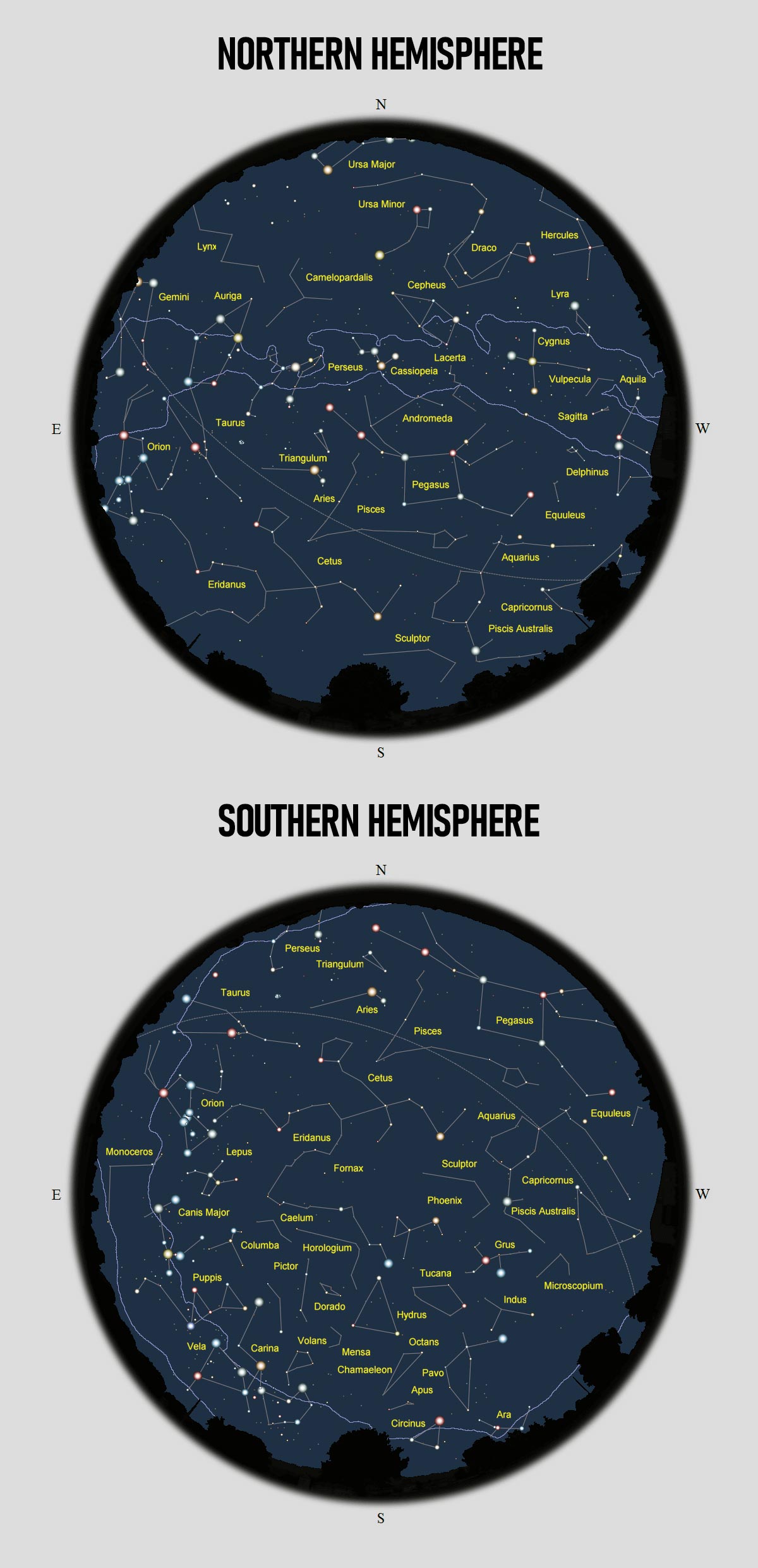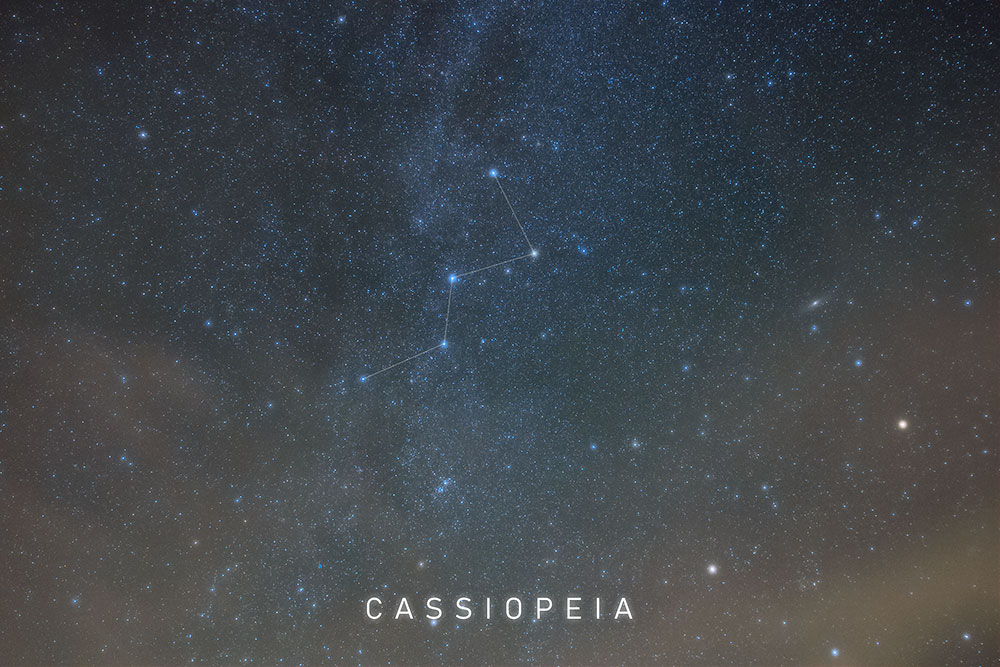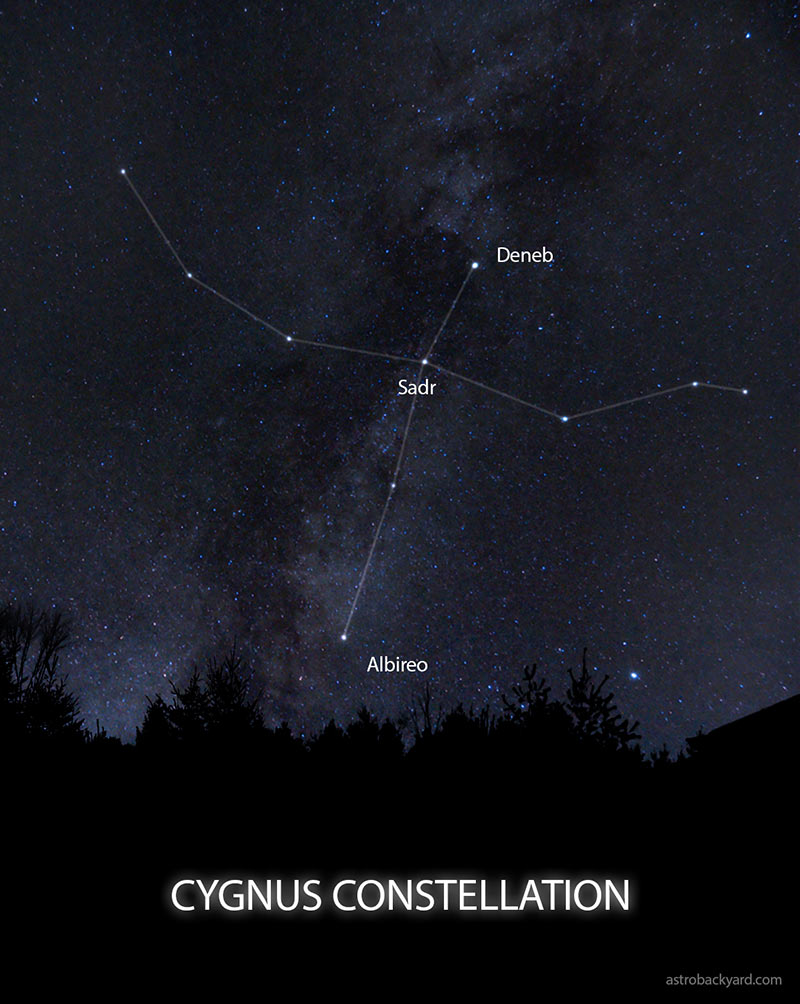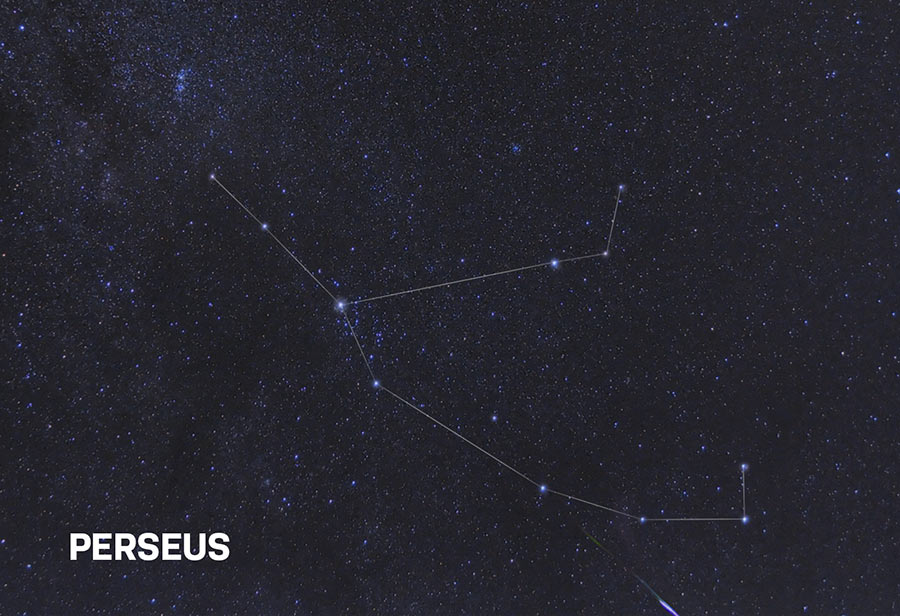Constellations
What is a Constellation?
Constellations are groups of stars that form patterns in the night sky, often named after animals, creatures, or mythological people resembling the outline or pattern. The word ‘constellation’ comes from the Latin ‘constellacio’ which means ‘set of stars’.
Of the billions of stars in the universe, only a fraction make up the shapes of our constellations. These include stars that are easily seen with the naked eye.
It may look like all the stars in a constellation are all at the same distance from Earth, however, a constellation may contain several stars from varying distances.
The difference in the size of the star and its brightness will affect our ability to view all stars in the constellation, with some appearing more or less noticeable.
Constellations will gradually shift west throughout the year due to the Earth’s orbit around the Sun.
Therefore, there are constellations known for the different seasons since viewers are looking at a different set of constellations from summer to winter. For example, Cygnus is a prominent summer constellation, and Orion is a prominent winter constellation.
This also means that not all constellations can be seen from every location on Earth and that some can only be seen from northern or southern latitudes.
For example, Crux and Carina are only visible from the southern hemisphere and Ursa Major/Minor and Cassiopeia are only visible in the northern hemisphere.
Constellation Versus Asterism
A constellation differs from an asterism in that an asterism is a well-known and/or obvious group or pattern of stars but is not a formally named constellation (i.e. Winter and Summer Triangle).
These star groupings are still used to navigate the night sky and many contain or share stars within a constellation.
For example, the Winter Triangle asterism is a pattern of stars made up of Betelgeuse, Sirius, and Procyon which are stars from the constellations Orion, Canis Major, and Canis Minor.
Another example of an asterism in the night sky is The Big Dipper. This pattern of stars is one of the most familiar sights in the northern sky.
The Big Dipper is a prominent group of stars within the larger constellation of Ursa Major (The Great Bear). The stars in an asterism are usually close together, and about the same brightness.
The Big Dipper is one of the most familiar asterisms in the night sky (not a constellation).
Origins of Constellations
The earliest constellations told stories of beliefs, creation or mythology with many cultures and countries adopting their own constellations.
Some of these early constellations became part of the current list of constellations that are internationally recognized, while others changed significantly over time, were limited to certain cultures or countries, or eliminated altogether.
The majority of constellation names we are familiar with came from the ancient Greek and Roman civilizations. There are 48 constellations from traditional Western constellations.
Constellations from the southern sky were added when European explorers began traveling to this hemisphere in the 15th century.
Around 1920, the International Astronomical Union (IAU) formally accepted and recognized the modern and ancient list of 88 constellations, and later adopted official boundaries to cover the celestial sphere.
Each star within the constellation boundary is considered to be part of that constellation, even if it is not part of the actual pattern.
Of the 88 constellations, 36 lie predominantly in the northern sky, and 52 in the southern sky.
Scorpius constellation boundary by IAU and Sky and Telescope.
Northern and Southern Sky Constellations
Constellation List
| Latin Name | English Name/ Description |
|---|---|
| Andromeda | Princess of Ethiopia |
| Antlia | Air pump |
| Apus | Bird of Paradise |
| Aquarius | Water bearer |
| Aquila | Eagle |
| Ara | Altar |
| Aries | Ram |
| Auriga | Charioteer |
| Bootes | Herdsman |
| Caelum | Graving tool |
| Camelopardalis | Giraffe |
| Cancer | Crab |
| Canes Venatici | Hunting dogs |
| Canis Major | Big dog |
| Canis Minor | Little dog |
| Capricornus | Sea goat |
| Carina | Keel of Argonauts' ship |
| Cassiopeia | Queen of Ethiopia |
| Centaurus | Centaur |
| Cepheus | King of Ethiopia |
| Cetus | Sea monster (whale) |
| Chamaeleon | Chameleon |
| Circinus | Compasses |
| Columba | Dove |
| Coma Berenices | Berenice's hair |
| Corona Australis | Southern crown |
| Corona Borealis | Northern crown |
| Corvus | Crow |
| Crater | Cup |
| Crux | Cross (southern) |
| Cygnus | Swan |
| Delphinus | Porpoise |
| Dorado | Swordfish |
| Draco | Dragon |
| Equuleus | Little horse |
| Eridanus | River |
| Fornax | Furnace |
| Gemini | Twins |
| Grus | Crane |
| Hercules | Hercules, son of Zeus |
| Horologium | Clock |
| Hydra | Sea serpent |
| Hydrus | Water snake |
| Indus | Indian |
| Lacerta | Lizard |
| Leo | Lion |
| Leo Minor | Little lion |
| Lepus | Hare |
| Libra | Balance |
| Lupus | Wolf |
| Lynx | Lynx |
| Lyra | Lyre or harp |
| Mensa | Table mountain |
| Microscopium | Microscope |
| Monoceros | Unicorn |
| Musca | Fly |
| Norma | Carpenter's Level |
| Octans | Octant |
| Ophiuchus | Holder of serpent |
| Orion | Orion, the hunter |
| Pavo | Peacock |
| Pegasus | Pegasus, the winged horse |
| Perseus | Perseus, hero who saved Andromeda |
| Phoenix | Phoenix |
| Pictor | Easel |
| Pisces | Fishes |
| Piscis Austrinus | Southern fish |
| Puppis | Stern of the Argonauts' ship |
| Pyxis | Compass on the Argonauts' ship |
| Reticulum | Net |
| Sagitta | Arrow |
| Sagittarius | Archer |
| Scorpius | Scorpion |
| Sculptor | Sculptor's tools |
| Scutum | Shield |
| Serpens | Serpent |
| Sextans | Sextant |
| Taurus | Bull |
| Telescopium | Telescope |
| Triangulum | Triangle |
| Triangulum Australe | Southern triangle |
| Tucana | Toucan |
| Ursa Major | Big bear |
| Ursa Minor | Little bear |
| Vela | Sail of the Argonauts' ship |
| Virgo | Virgin |
| Volans | Flying fish |
| Vulpecula | Fox |
Table data from Astrophysics Science Division (ASD) at NASA/ GSFC.
Famous Constellations
Cassiopeia
Cassiopeia is a large constellation in the northern hemisphere, known as the ‘W’ constellation based on the pattern that is formed by its five brightest stars. There are a total of eight stars in this constellation which is located opposite the Big Dipper asterism.
Neighboring constellations are Andromeda, Camelopardalis, Cepheus, Lacerta, and Perseus.
Cassiopeia contains several deep-sky objects including; Messier 52, Messier 103, the Heart Nebula and the Soul Nebula, the Pacman Nebula, and the White Rose Cluster.
In Greek mythology, queen Cassiopeia is the wife of King Cepheus and mother to Andromeda. It is said that Cassiopeia was punished for her vanity by the sea god Poseidon by remaining upside down in the sky for six months of the year.
Centaurus
Centaurus is the ninth largest constellation in the sky and is located in the southern hemisphere. It contains Alpha Centauri and Beta Centauri, two of the top ten brightest stars in the sky and Centaurus A which is one of the brightest galaxies in the night sky.
Neighboring constellations include Antlia, Carina, Circinus, Crux, Hydra, Libra, Lupus, Musca, and Vela.
This constellation contains no Messier objects.
The Centaurus constellation represents a half-man, half-horse creature from Greek mythology and is usually associated with another wise centaur.
Cygnus
Cygnus is located in the northern hemisphere and contains the Northern Cross, a well-known asterism.
Neighboring constellations include; Cepheus, Draco, Lacerta, Lyra, Pegasus, and Vulpecula.
Cygnus contains several well-known nebulae including; the Pelican Nebula, the North America Nebula, the Crescent Nebula, Sadr Region, the Eastern/Western Veil Nebula as well as Messier 29, Messier 39.
The mythology of the Cygnus constellation involves Leda, the Spartan queen who was seduced by Zeus in the form of a swan. Leda then gave birth to two sets of twins, one set mortal (father by Leda’s husband) and one set immortal (fathered by Zeus).
Orion
Orion is one of the best-known, brightest constellations in the night sky and contains one of the most noticeable asterisms in the night sky, Orion’s belt.
Neighboring constellations include Eridanus, Gemini, Lepus, Monoceros, and Taurus.
The constellation Orion contains Rigel and Betelgeuse, two of the ten brightest stars in the night sky, in addition to the Orion Nebula (Messier 42), De Mairan’s Nebula (Messier 43), the Horsehead Nebula, and the Trapezium Cluster.
While there are many different myths of this constellation, Orion is known as the hunter with two hunting dogs, represented by Canis Major and Canis Minor.
Perseus
Perseus is a northern constellation, known for its annual meteor shower in the summer.
Neighboring constellations include Andromeda, Aries, Auriga, Camelopardalis, Cassiopeia, Taurus, and Triangulum.
There are many deep-sky objects in Persius including Messier 34, the Double Cluster, the California Nebula (NGC 1499) and the Little Dumbbell Nebula (Messier 76).
According to Greek mythology, the Perseus constellation is a representation of the Greek hero who was the son of Danaë, daughter of King Acrisius. Danaë and Perseus were locked in a wooden chest by the King. The chest was found by a fisherman who took them in and raised Perseus as his son. Perseus would later marry Andromeda and have many children.
Ursa Major
Ursa Major, the great bear, is well-known and one of the oldest constellations dating back to ancient times. The brightest stars in the constellation also form the Big Dipper asterism with four stars shaping a bowl and three define a handle.
It is the largest northern constellation and contains Bode’s Galaxy, the Cigar Galaxy, the Owl Nebula, and the Pinwheel Galaxy (M101).
There are many legends that associate Ursa Major with a bear. According to the ancient Greeks, the bear represents Callisto, a beautiful nymph Zeus fell in love with. Callisto was turned into a bear by Zeus’ jealous wife, Hera.
Zodiac Constellations
Of the 88 accepted and recognized constellations, there are twelve constellations that also belong to the zodiac. These constellations are located along the plane of the ecliptic, where the sun will pass through these constellations throughout the course of one year.
The zodiac constellations as seen from Earth. (ABC: Julie Ramsden)
The zodiac is divided into twelve signs that are loosely tied to the constellations. In ancient times they were used to determine the time of year. Today they are mostly associated with horoscopic astrology.
The word zodiac comes from ‘zōidiakos’, which means ‘circle of animals’ in Greek, with seven of the zodiac constellations represented by animals.
The twelve zodiac constellations include:
- Aries (Ram)
- Aquarius
- Cancer (Crab)
- Capricornus (Goat)
- Gemini
- Leo (Lion)
- Libra
- Pisces (Fish)
- Sagittarius
- Scorpius (Scorpion)
- Taurus (Bull)
- Virgo
Constellation Facts
- There are 88 recognized constellations
- A total of 36 lie predominantly in the northern sky
- A total of 52 lie predominantly in the southern sky
- There are official constellation boundaries that cover the entire celestial sphere. Each star within the boundary are considered to be part of the constellation even if they are not represented in the pattern of the constellation.
- There are twelve constellations part of the zodiac which is tied to astrology
- The largest constellation by area is Hydra
- The smallest constellation by area is Crux
- Asterisms are different from constellations. The Big Dipper is not a constellation, but an asterism that involves stars from the constellation Ursa Major
Constellation Apps
If you are interested in learning more about the constellations, there are several planetarium applications available for your cell phone. Below are three options that are free for download (with in-app store purchases) for Android or Apple phones.
Stellarium – is a planetarium available as a phone app or on your web browser. It shows realistic star maps, so you can identify stars, constellations, planets, etc.
Star Walk – is an interactive star-gazing phone application that will show you celestial objects. There is a second, paid edition of this app (Star Walk 2) as well as the free version.
Skyview Lite – a star-gazing phone application for identifying the stars, constellations, etc.
For a more detailed review of the above applications and for a larger list of useful astronomy applications, visit ‘The 19 Best Astronomy Apps for Stargazing’ post.












